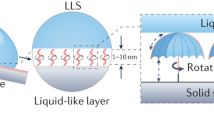Abstract
Here, we report for the first time the use of poly(3,4-propylenedioxythiophene) as platform for surface post-functionalization using the Staudinger-Vilarrasa reaction in order to covalently link perfluorinated chains and obtain various hydrophobic/oleophobic properties. 3,4-propylenedioxythiophene with one or two azido groups are prepared, in order to determine the impact of the number of functional groups on the surface morphology and wettability. Here, we show the possibility to prepare parahydrophobic (high water adhesion) or superhydrophobic (low water adhesion) surfaces with highly oleophilic to highly oleophobic properties.












Similar content being viewed by others
References
Yan YY, Gao N, Barthlott W (2011) Mimicking natural superhydrophobic surfaces and grasping the wetting process: A review on recent progress in preparing superhydrophobic surfaces. Adv Colloid Interface Sci 169:80–105
Wang X, Ding B, Yu J, Wang M (2011) Engineering biomimetic superhydrophobic surfaces of electrospun nanomaterials. Nano Today 6:510–530
Oberli L, Caruso D, Hall C, Fabretto M, Murphy PJ, Evans D (2014) Condensation and freezing of droplets on superhydrophobic surfaces. Adv Colloid Interface Sci 210:47–57
Zhang P, Lv FY (2015) A review of the recent advances in superhydrophobic surfaces and the emerging energy-related applications. Energy 82:1068–1087
Marmur A (2012) Hydro- hygro- oleo- omni-phobic? terminology of wettability classification. Soft Matter 8:6867–6870
Watson GS, Green DW, Schwarzkopf L, Li X, Cribb BW, Myhra S, Watson JA (2015) A gecko skin micro/nano structure - A low adhesion, superhydrophobic, anti-wetting, self-cleaning, biocompatible, antibacterial surface. Acta Biomater 21:109–122
Karapanagiotis I, Manoudis PN, Zurba A, Lampakis D (2014) From hydrophobic to superhydrophobic and superhydrophilic siloxanes by thermal treatment. Langmuir 30:13235–13243
Bellanger H, Darmanin T, Taffin de Givenchy E, Guittard F (2014) Chemical and physical pathways for the preparation of superoleophobic surfaces and related wetting theories. Chem Rev 114:2694–2716
Hensel R, Neinhuis C, Werner C (2016) The springtail cuticle as a blueprint for omniphobic surfaces. Chem Soc Rev 45:323–341
Starostin A, Valtsifer V, Strelnikov V, Bormashenko E, Grynyov R, Bormashenko Y, Gladkikh A (2014) Robust technique allowing the manufacture of superoleophobic (omniphobic) metallic surfaces. Adv Eng Mater 16:1127–1132
Liu T, Kim C-J (2014) Turning a surface superrepellent even to completely wetting liquids. Science 346:1096–1100
Szczepanski CR, Darmanin T, Guittard F (2015) Using poly(3,4-ethylenedioxythiophene) containing a carbamate linker as a platform to develop electrodeposited surfaces with tunable wettability and adhesion. RSC Adv 5:89407–89414
Ramos Chagas G, Darmanin T, Guittard F (2015) Nanostructured superhydrophobic films by electrodeposition of fluorinated polyindoles. Beilstein J Nanotechnol 6:2078–2087
Mortier C, Darmanin T, Guittard F (2014) Major influence of the alkyl chain length of poly(2,4-dialkyl-3,4-propylenedioxythiophene) on the surface fibrous structures and hydrophobicity. Polym Adv Technol 25:1252–1256
Darmanin T, Diouf A, El-Maiss J, Dieng SY, Guittard F (2015) Control over water adhesion of nanostructured parahydrophobic films using mesh substrates. ChemNanoMat 1:497–501
Kerszulis JA, Amb CM, Dyer AL, Reynolds JR (2014) Follow the yellow brick road: structural optimization of vibrant yellow-to-transmissive electrochromic conjugated polymers. Macromolecules 47:5462–5469
Estrada LA, Deininger JJ, Kamenov GD, Reynolds JR (2013) Direct (hetero)arylation polymerization: An effective route to 3,4-propylenedioxythiophene-based polymers with low residual metal content. ACS Macro Lett 2:869–873
Beaujuge PM, Vasilyeva SV, Liu DY, Ellinger S, McCarley TD, Reynolds JR (2012) Structure-performance correlations in spray-processable green dioxythiophene-benzothiadiazole donor–acceptor polymer electrochromes. Chem Mater 24:255–268
Mortier C, Darmanin T, Guittard F (2014) The major influences of substituent size and position of 3,4-propylenedioxythiophene on the formation of highly hydrophobic nanofibers. ChemPlusChem 79:1434–1439
Iha RK, Wooley KL, Nystrom AM, Burke DJ, Kade MJ, Hawker CJ (2009) Applications of orthogonal “click” chemistries in the synthesis of functional soft materials. Chem Rev 109:5620–5686
Lancuski A, Fort S, Bossard F (2012) Electrospun azido-PCL nanofibers for enhanced surface functionalization by click chemistry. ACS Appl Mater Interfaces 4:6499–6504
Huisgen R (1984) In 1,3-Dipolar cycloaddition chemistry. Wiley, New York, pp. 1–176
Rostovtsev VV, Green LG, Fokin VV, Sharpless KBA (2002) A stepwise Huisgen cycloaddition process: Copper(I)-catalyzed regioselective “ligation” of azides and terminal alkynes. Angew Chem Int Ed 41:2596–2599
Bu H-B, Goetz G, Reinold E, Vogt A, Azumi R, Segura JL, Baeuerle P (2012) “click”-modification of a functionalized poly(3,4-ethylenedioxythiophene) (PEDOT) soluble in organic solvents. Chem Commun 48:2677–2679
Godeau G, N’Na J, Darmanin T, Guittard F (2015) Azidomethyl-EDOT as a platform for tunable surfaces with nanostructures and superhydrophobic properties. J Phys Chem B 119:6873–6877
Nair DP, Podgórski M, Chatani S, Gong T, Xi W, Fenoli CR, Bowman CN (2014) The thiol-Michael addition click reaction: A powerful and widely used tool in materials chemistry. Chem Mater 26:724–744
Burés J, Martín M, Urpí F, Vilarrasa J (2009) Catalytic staudinger-vilarrasa reaction for the direct ligation of carboxylic acids and azides. J Org Chem 74:2203–2206
Godeau G, Darmanin T, Guittard F (2015) Staudinger vilarassa reaction: A powerful tool for surface modification and superhydrophobic properties. J Colloid Interface Sci 457:72–77
Feng L, Zhang Y, Xi J, Zhu Y, Wang N, Xia F, Jiang L (2008) Petal effect: A superhydrophobic state with high adhesive force. Langmuir 24:4114–4119
Bormashenko E, Stein T, Pogreb R, Aurbach D (2009) “Petal effect” on surfaces based on lycopodium: high stick surfaces demonstrating high apparent contact angles. J Phys Chem C 113:5568–5572
Acknowledgments
We thank J.-P. Laugier and François Orange of the Centre Commun de Microscopie Appliquée (CCMA, Univ. Nice Sophia Antipolis) for the SEM Images.
Author information
Authors and Affiliations
Corresponding author
Electronic supplementary material
ESM 1
(DOC 86 kb)
Rights and permissions
About this article
Cite this article
Godeau, G., Darmanin, T. & Guittard, F. Superhydrophobic/highly oleophobic surfaces based on poly(3,4-propylenedioxythiophene) surface post-functionalization. J Polym Res 23, 81 (2016). https://doi.org/10.1007/s10965-016-0969-6
Received:
Accepted:
Published:
DOI: https://doi.org/10.1007/s10965-016-0969-6




